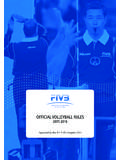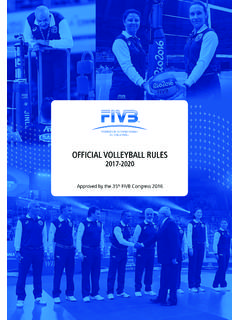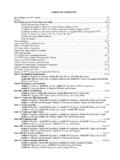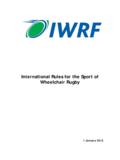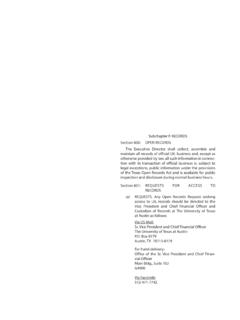Transcription of RULES of THROWBALL - uspza.cz
1 RULES of THROWBALL Czech Special Olympic Games Movement 2 Introduction According to SOI RULES , Article I, Section P, the Czech Special Olympic Games Movement submits herewith a proposal to acknowledge THROWBALL as a national popular sport. The said game has developed in several regions of the Czech Republic since 1968. THROWBALL tournaments became regular parts of sporting competitions of mentally handicapped youth. THROWBALL originated from the need to create a competitive ball game that would employ basic skills in ball throwing and catching, and would enable their development in various game situations. The game is a suitable means of training for other more demanding games of mentally handicapped people like basketball, volleyball or handball. THROWBALL is suitable for players on lower capability levels. Handling the ball on the home side of the playing field provides a good chance to those slowly moving and those with retarded reactivity and decision abilities.
2 While playing, space orientation, mobility and motorics are trained. Also thinking is developed, and tactics are trained when playing. THROWBALL is a suitable unifying game in which some of the team members, in the initial training stages, help in organizing the game and support the handicapped players in acquiring correct skills. The partners and their mentally handicapped co-players together form a tournament team, which brings pleasure to both sides. Czech Special Olympic Games Movement 3 RULES Article I: Official Competitions 1. Team matches 2. Test of individual skills 3. Unified team matches Article II: Playing Field and Equipment a) Dimensions of Playing Field The playing field is a rectangle 14m in length and 9m in width. The mentioned dimensions include 5-cm-wide lines. A protest against the field s dimensions and/or equipment can be placed 1/2 hour before the match at the latest.
3 B) Marking of Playing Field The playing field is marked out by well visible lines of 5 cm width. Indoor field boundaries (lines) must be at least 1m clear of any solid objects in the gym, and at least 2m in case of open air fields. It is forbidden to mark the lines by use of cords, laths and similar objects. c) Posts The field-side edge of the net posts must be at least 1m from the side lines. d) Net The net is 100 cm wide and at least 10 m long with a 10x10 cm mesh. The net is fixed exactly above the center line. Its upper edge is hemmed on both sides with a 5 cm wide white tape. 7 m 14 m m m m m Post 9 m Center line Czech Special Olympic Games Movement 4 e) Net Height Measured at the upper edge of the net above the center of the playing field : Women .. 210 cm Boys up to 15 years of age.
4 210 cm Men from 16 years of age .. 241 cm Mixed teams .. 241 cm f) Ball The ball is made of leather (similar to a volleyball), maximum 71 cm in circumference. Article III: Referees Two referees rule the match, a score-keeper assists them. Duties of 1st referee: The 1st referee decides when the ball is in play, when a point is scored, measures time-outs (uses a whistle). Prior to the match he verifies whether the playing field and ball correspond to the RULES and checks the identity of the players according to the list. The ruling of the 1st referee is always final. The position of the 1st referee is behind the post. His eye level should be at least 50 cm above the upper edge of the net. Duties of 2nd referee: The 2nd referee oversees the sidelines and center line, signals out balls, and checks the players rotation after scoring a point.
5 Duties of the score-keeper: The score-keeper keeps the score and notes time-outs. He announces the match score after each loss (fault). Article IV: Players and Substitutes a) Each team consists of 6 players and any number of substitutes up to 6. Three boys and three girls (all mentally handicapped) form a mixed team. b) The coach changes players. He notifies any referee verbally or by signaling. Changes can be made only when the ball is not in play. Signal for change of a player : one hand vertically circles around the second hand. The new player (substitute) notifies himself to the referee by raising his hand and replaces the leaving player in the same field position. Upon taking the position the former player immediately leaves the filed also notifying the referee by raising his hand. Czech Special Olympic Games Movement 5 Two changes are allowed in each set.
6 An indisposed player can be changed any time. The team may enter a new set in a different configuration. Czech Special Olympic Games Movement 6 c) Time-out Each team has one time-out (2 minutes) in the course of one match. The coach notifies a referee verbally or by signaling. Time-out is signaled by forming a T with both hands in front of the body. d) Dress The team must ware uniform dresses. In cold weather track suits are allowed. Each player must carry a number (15 cm on back, 10 cm on chest). e) Conduct All players, substitutes and coaches must keep discipline and adhere to game RULES . The referee may punish someone s disorderly behavior by either giving a warning or ruling out the person or by losing a point. Article V: Game RULES a) Choice of Sides and Service The teams draw lots using a coin.
7 The winner of the draw has the right to choose either a side or first service. In case the winner of the draw chooses first service the opposite team chooses sides. The teams take turns in the advantage of first service. A new draw is done before the decisive (third) set. b) Number and Position of Players Each team nominates 6 players positioned on their side of the field as follows: 3 at the net (offensive half) 3 in the 2nd row (defensive half) During the game the players may move freely within their field. However during service they must keep their initial positions. c) Service Service is given by a right back. The player serves immediately after the referee's whistle. Serving is performed by throwing the ball from any position behind the back line to any area in the opposite field (the ball must be thrown, not hit or smashed).
8 If the ball touches the net this is not considered as a mistake. A ball that ends in the net or out of the opposite filed results in a point for the opposite team. Czech Special Olympic Games Movement 7 d) RULES The ball may be played by any part of the player's body above the waist ( the head). A team may touch the ball three times to deliver it into the opposite field ( after two passes the third ball must be played [thrown or smashed] into the opposite field). In home field, the players are allowed to catch and thrown, or strike the ball. Between individual passes, the ball must not touch the ground or any other object. A player can play the ball even when standing out of his field and the game continues. If two players touch the ball at the same time the next ball must be delivered into the opposite field otherwise a fault is announced and the opposite team gains a point.
9 It is not allowed to make more than three steps when holding the ball. More steps are considered as a fault and a point for the opposite team. A player may hold the ball for maximum three seconds. Holding the ball more than 3 seconds is a fault resulting in a point for the opposite team. A player is not allowed to touch the net even when delivering the ball to the opposite side. Each touch of the net is considered as a fault, which results in a point for the opponent. The ball itself may however touch the net when being delivered to the other side - as long as it lands in the opponents field it is not considered as a fault. Smash - is an offensive ball which can be made by either one or both hands. While smashing the player s hand(s) may cross over the net without touching it. Interference with the net is a fault and a point for the opponent. Block - is a way of defense against the opponent s attack performed with both hands raised in close proximity to the net.
10 Only Forwards may block. If those blocking touch the ball it will be considered as the first touch of the 3-touch rule. After an unsuccessful block, the same player may catch or hit the ball again. If the blocking Forward misses the ball his hand(s) may cross over the net without touching it. The same applies following a (successful) block. e) Point and Loss of Service If a player makes a fault (does not catch or drops the ball etc.) the opposite team receives both a point and the right to serve. Each time the team gains a point and service a new player serves. The serving player always rotates one position clockwise. All other players of the team shift the same way. Czech Special Olympic Games Movement 8 f) Set The team that has reached 15 points wins the set. The minimum difference in score is two points (15:13).
